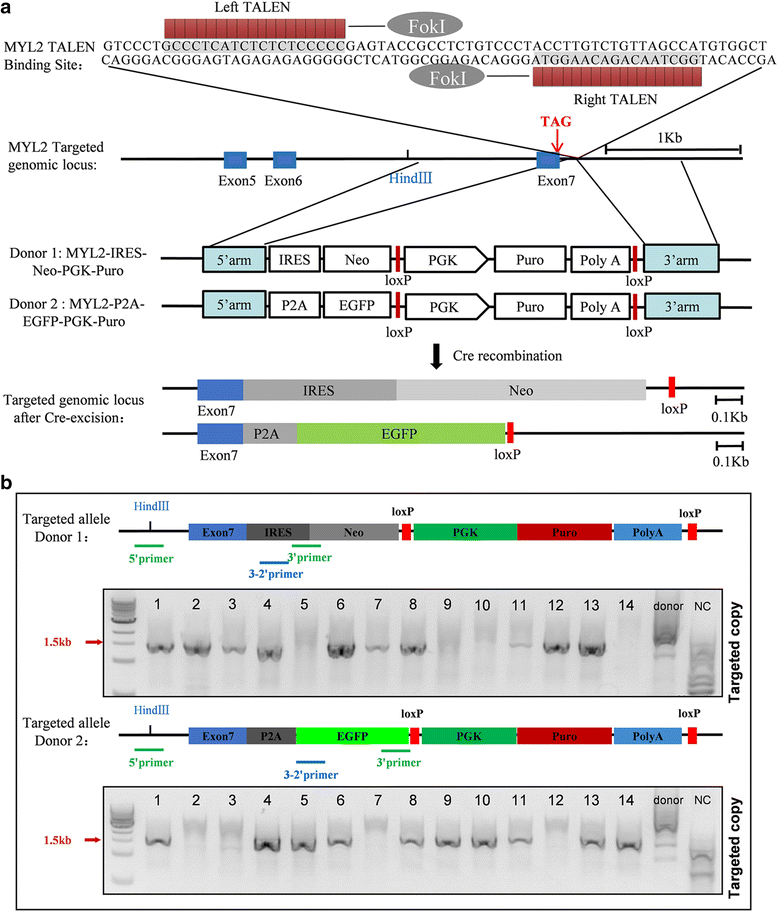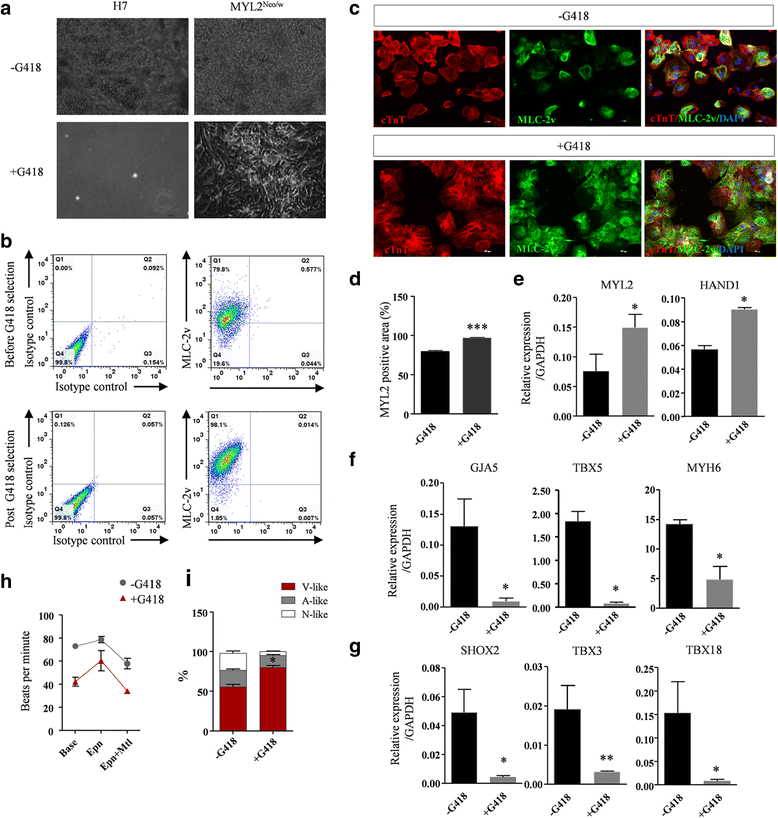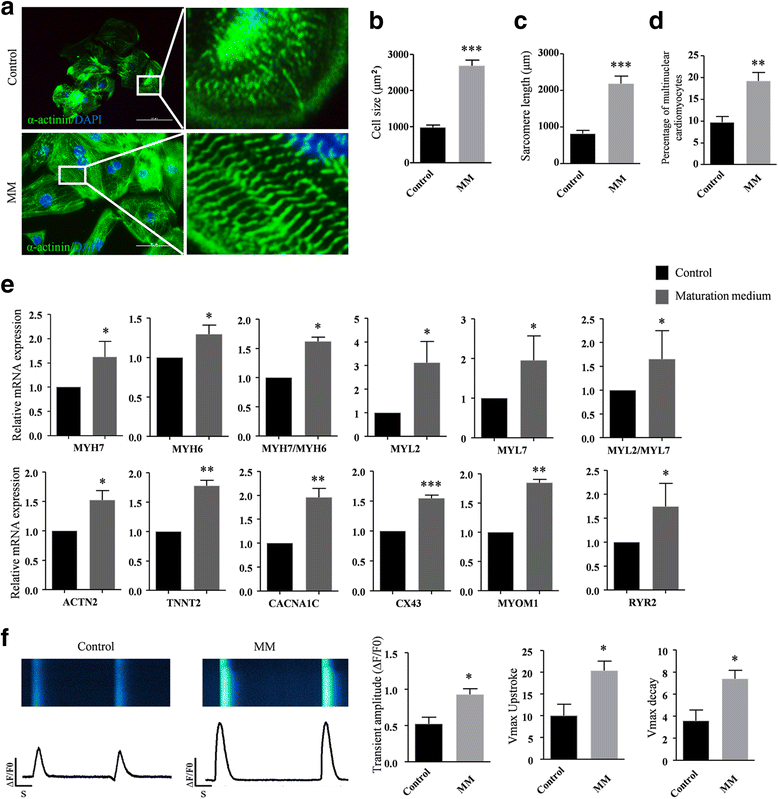Engineering human ventricular heart muscles based on a highly efficient system for purification of human pluripotent stem cell-derived ventricular cardiomyocytes
- PMID: 28962583
- PMCID: PMC5622416
- DOI: 10.1186/s13287-017-0651-x
Engineering human ventricular heart muscles based on a highly efficient system for purification of human pluripotent stem cell-derived ventricular cardiomyocytes
Abstract
Background: Most infarctions occur in the left anterior descending coronary artery and cause myocardium damage of the left ventricle. Although current pluripotent stem cells (PSCs) and directed cardiac differentiation techniques are able to generate fetal-like human cardiomyocytes, isolation of pure ventricular cardiomyocytes has been challenging. For repairing ventricular damage, we aimed to establish a highly efficient purification system to obtain homogeneous ventricular cardiomyocytes and prepare engineered human ventricular heart muscles in a dish.
Methods: The purification system used TALEN-mediated genomic editing techniques to insert the neomycin or EGFP selection marker directly after the myosin light chain 2 (MYL2) locus in human pluripotent stem cells. Purified early ventricular cardiomyocytes were estimated by immunofluorescence, fluorescence-activated cell sorting, quantitative PCR, microelectrode array, and patch clamp. In subsequent experiments, the mixture of mature MYL2-positive ventricular cardiomyocytes and mesenchymal cells were cocultured with decellularized natural heart matrix. Histological and electrophysiology analyses of the formed tissues were performed 2 weeks later.
Results: Human ventricular cardiomyocytes were efficiently isolated based on the purification system using G418 or flow cytometry selection. When combined with the decellularized natural heart matrix as the scaffold, functional human ventricular heart muscles were prepared in a dish.
Conclusions: These engineered human ventricular muscles can be great tools for regenerative therapy of human ventricular damage as well as drug screening and ventricular-specific disease modeling in the future.
Keywords: Engineered human heart tissues; Engineered human ventricular heart muscles; Human pluripotent stem cells; Human ventricular cardiomyocytes; Myosin light chain 2; Myosin light chain 2v.
Conflict of interest statement
Ethics approval
All animal experiments in this study were approved by the Institutional Animal Care and Use Committee of the Fudan University (Committee approval number: 20140423) and were performed in accordance with the Guide for the Care and Use of Laboratory Animals (National Institutes of Health). All human stem cells research followed the ISSCR Guidelines for the Conduct of Human Embryonic Stem Cell Research. The human ESC line H7 used in this study was obtained from WiCell Research Institute under specific Material Transfer Agreement. The human iPSC line was derived from human skin fibroblasts with informed consent approved previously by the Bioethics Committee of Zhongshan Hospital affiliated to Fudan University.
Consent for publication
All authors have contributed to, read, and approved the final manuscript for submission.
Competing interests
The authors declare that they have no competing interests.
Publisher’s Note
Springer Nature remains neutral with regard to jurisdictional claims in published maps and institutional affiliations.
Figures








Similar articles
-
Myosin light chain 2 marks differentiating ventricular cardiomyocytes derived from human embryonic stem cells.Pflugers Arch. 2021 Jul;473(7):991-1007. doi: 10.1007/s00424-021-02578-3. Epub 2021 May 24. Pflugers Arch. 2021. PMID: 34031754
-
Isolation and characterization of ventricular-like cells derived from NKX2-5eGFP/w and MLC2vmCherry/w double knock-in human pluripotent stem cells.Biochem Biophys Res Commun. 2018 Jan 1;495(1):1278-1284. doi: 10.1016/j.bbrc.2017.11.133. Epub 2017 Nov 22. Biochem Biophys Res Commun. 2018. PMID: 29175323
-
Myosin light chain 2-based selection of human iPSC-derived early ventricular cardiac myocytes.Stem Cell Res. 2013 Nov;11(3):1335-47. doi: 10.1016/j.scr.2013.09.003. Epub 2013 Sep 18. Stem Cell Res. 2013. PMID: 24095945 Free PMC article.
-
Maturing human pluripotent stem cell-derived cardiomyocytes in human engineered cardiac tissues.Adv Drug Deliv Rev. 2016 Jan 15;96:110-34. doi: 10.1016/j.addr.2015.04.019. Epub 2015 May 5. Adv Drug Deliv Rev. 2016. PMID: 25956564 Free PMC article. Review.
-
Functions of myosin light chain-2 (MYL2) in cardiac muscle and disease.Gene. 2015 Sep 10;569(1):14-20. doi: 10.1016/j.gene.2015.06.027. Epub 2015 Jun 12. Gene. 2015. PMID: 26074085 Free PMC article. Review.
Cited by
-
Myosin light chain 2 marks differentiating ventricular cardiomyocytes derived from human embryonic stem cells.Pflugers Arch. 2021 Jul;473(7):991-1007. doi: 10.1007/s00424-021-02578-3. Epub 2021 May 24. Pflugers Arch. 2021. PMID: 34031754
-
Applications of Tissue Decellularization Techniques in Ventricular Myocardial Biofabrication.Front Bioeng Biotechnol. 2022 Feb 21;10:802283. doi: 10.3389/fbioe.2022.802283. eCollection 2022. Front Bioeng Biotechnol. 2022. PMID: 35265593 Free PMC article. Review.
-
New Strategies to Enhance Myocardial Regeneration: Expectations and Challenges from Preclinical Evidence.Curr Stem Cell Res Ther. 2020;15(8):696-710. doi: 10.2174/1574888X15666200225124451. Curr Stem Cell Res Ther. 2020. PMID: 32096748 Free PMC article. Review.
-
Subtype-specific cardiomyocytes for precision medicine: Where are we now?Stem Cells. 2020 Jul;38(7):822-833. doi: 10.1002/stem.3178. Epub 2020 Apr 27. Stem Cells. 2020. PMID: 32232889 Free PMC article. Review.
-
Statins affect human iPSC-derived cardiomyocytes by interfering with mitochondrial function and intracellular acidification.Basic Res Cardiol. 2024 Apr;119(2):309-327. doi: 10.1007/s00395-023-01025-x. Epub 2024 Feb 2. Basic Res Cardiol. 2024. PMID: 38305903
References
Publication types
MeSH terms
Substances
Grants and funding
LinkOut - more resources
Full Text Sources
Other Literature Sources

